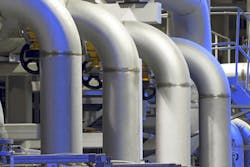To the casual observer, a flow stream that is turbulent is sometimes misconstrued to have turbulence and vice versa. Parts of my Industrial Flow Measurement seminar build on the concept of Reynolds number, its relationship to velocity profile and turbulence (which has nothing to do with Reynolds number but is related to the velocity profile). Let me explain.
Reynolds number is the ratio of the inertial forces trying to push the fluid downstream to the viscous forces that try to resist the fluid from flowing. Operation at a Reynolds number above approximately 4,000 is considered to be in the turbulent flow regime and exhibits a velocity profile that is relatively flat with similar local velocities in most of the pipe. This contrasts operating in the laminar flow regime where the Reynolds number is under approximately 2,000 and the velocity profile is more bullet-shaped with higher velocities occurring at the center of the pipe. Reynolds numbers of approximately 2,000 to 4,000 indicate operation in the transitional flow regime where the flow exhibits the properties of the laminar flow regime, turbulent flow regime or both.
It is important to know at which flow regime(s) a flowmeter will operate, because some flowmeters operate properly in only one flow regime, others in two and yet others operate in all three. Some flowmeters turn off and measure zero flow when operated in one or more flow regimes.
Turbulence is present when the flow profiles described here are distorted. Turbulence can occur in any flow regime. For example, turbulence can be present downstream of a fitting in a flow that operates in the laminar flow regime. Stated differently, turbulence (distorted velocity profile) can be present in laminar flow. When the turbulent velocity profile is not distorted, no turbulence exists in the turbulent flow regime.
This may sound strange, but it represents important concepts in the quest to achieve good flowmeter performance.
David W. Spitzer is a regular contributor to Flow Control and a principal in Spitzer and Boyes LLC, which offers engineering, seminars, strategic, marketing consulting, distribution consulting and expert witness services for manufacturing and automation companies. Spitzer and Boyes is also the publisher of the Industrial Automation INSIDER. He has more than 40 years of experience and has written more than 10 books and 350 articles about flow measurement, instrumentation and process control. Spitzer may be reached at 845-623-1830 or via spitzerandboyes.com. Click on the "Products" tab to find his Consumer Guides to various flow and level measurement technologies.



